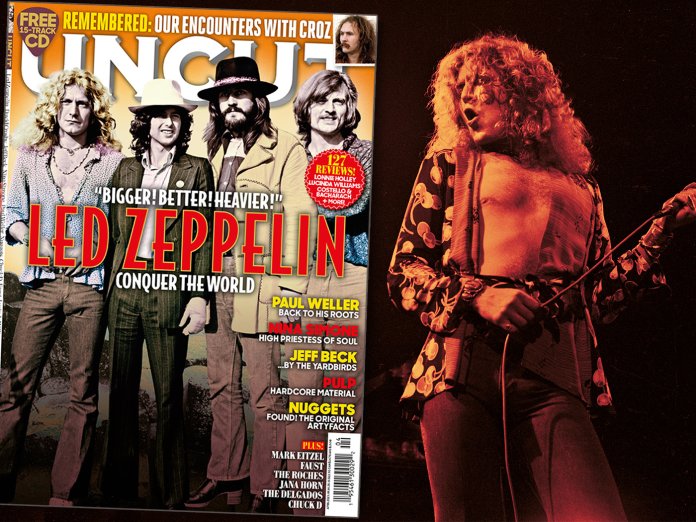By 1973, LED ZEPPELIN were on their way to becoming the biggest rock’n’roll band in the world. Embarking on an American tour to promote their new album Houses Of The Holy, they shattered box office records, rewriting the blueprint for rock’n’roll tours as they went. Peter Watts climbs aboard...
By 1973, LED ZEPPELIN were on their way to becoming the biggest rock’n’roll band in the world. Embarking on an American tour to promote their new album Houses Of The Holy, they shattered box office records, rewriting the blueprint for rock’n’roll tours as they went. Peter Watts climbs aboard the Starship to hear tales of glorious, transcendent music in the latest issue of Uncut magazine – in UK shops from Thursday, February 9 and available to buy from our online store.
July 29, 1973. Inside Madison Square Garden, the ground was shaking. It was the final night of Led Zeppelin’s 1973 tour of the United States and Eddie Kramer was recording the show behind the stage in Wally Heider’s Mobile Studio Truck. The three sold-out nights at the Garden marked the climax of a gargantuan trek in support of March’s multi-million selling album Houses Of The Holy. Over three months, Zep blazed across the States, playing to crowds that eclipsed The Rolling Stones’ huge American tour the previous year and breaking box office records held by The Beatles. From packed stadiums and surreal album covers to trashed hotel rooms, Zeppelin crafted a new reality, one that could even make the earth move.
“I was in the truck with my hands on the fader and all of a sudden it began moving up and down,” recalls Kramer. “It was like an earthquake. The audience was going crazy, cheering and stomping. When you can feel 20,000 people jumping up and down… well that gives you a moment to remember.”
Kramer was taping the Madison Square Garden show for The Song Remains The Same, a live album eventually released in ’76 alongside a rather bovine motion picture. It seemed apposite that Kramer should record the Garden show: after all, he’d been there the previous year, when the band had recorded Houses Of The Holy during unforgettable spring days at Mick Jagger’s Hampshire mansion. Back then, the band were looking to follow the blockbuster success of Led Zeppelin IV, expanding on their razor riffs and electric mayhem by embracing multiple styles and textures. While Zeppelin experienced the thrill of liberation in the studio, they also knew it was important to capture the vibe correctly.
“None of us really knew what we were doing,” admits Robert Plant. “We’d had a great deal of success, but it didn’t follow there would be more success as times move on. We wanted to spend time doing it properly and it was time well spent.”
America – a land Led Zeppelin had set out to conquer in 1969 – went wild. It seemed appropriate that the album title was a reference to the almost religious fervour experienced in the concert arena. Watching in New York from the side of the Garden stage – and sporting a knotted hankie and carrying a rubber monkey – was musician Roy Harper. Part of the entourage, the “emotional protection unit” that travelled with the band, Harper spent the tour in luxury hotels – the Drake in New York and the Hyatt in LA – before travelling to shows on the Starship, the band’s luxurious Boeing 720 private jet. Amid parties with George Harrison, cake fights with Robert Plant and motorbikes ridden along hotel corridors, Harper saw Zeppelin produce the goods on stage every single night. On this tour, he believes, the West was finally won.
“‘Unique’ is one of those words like ‘genius’ that is thrown around quite a lot, but Zeppelin were unique,” says Harper. “They pulled a crowd because of the bite, the sheer bite, of that. It became a thing – a walking, talking monster – and as the venues got bigger, they got better, heavier, because they could exercise control. It was a kind of magic and you were blasted into the middle of next week. You paid attention, because attention was being demanded. That wasn’t the same as being in England. You couldn’t pull that off in the Marquee.”
BP Fallon, the band’s effusive press officer, recalls the impact Led Zeppelin had the moment they arrived in a city on the Starship. Band and entourage were ushered into a fleet of limousines before speeding through the streets with a police escort, sirens wailing towards a stadium where 50,000 people awaited in feverish anticipation. “The Stones sang about sex,” he says. “The music of Led Zeppelin was sex. The audience knew that, the girls dug it and the guys too. This wasn’t a knitting lesson. And remember too, you can do a lot during a wild drum solo – especially if you’re not the drummer.”
PICK UP THE NEW ISSUE OF UNCUT TO READ THE FULL STORY



